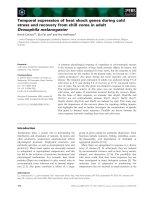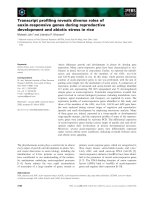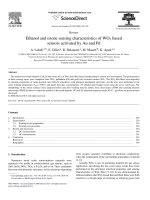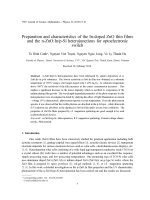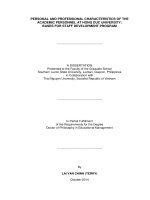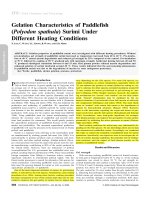Semen characteristics of NARI suwarna rams during breeding (Winter) and non-breeding (summer) seasons
Bạn đang xem bản rút gọn của tài liệu. Xem và tải ngay bản đầy đủ của tài liệu tại đây (718.76 KB, 13 trang )
Int.J.Curr.Microbiol.App.Sci (2020) 9(8): 312-324
International Journal of Current Microbiology and Applied Sciences
ISSN: 2319-7706 Volume 9 Number 8 (2020)
Journal homepage:
Original Research Article
/>
Semen Characteristics of NARI Suwarna Rams during Breeding (Winter)
and Non-breeding (Summer) Seasons
Venkanagouda Doddagoudar*, M. K. Tandle, R. G. Bijurkar, N. A. Patil,
Ashok Pawar, Shrikant Kulkarni and Vinay Tikare
Veterinary College, KVAFSU, Nandinagar, Bidar, Karnataka, India
*Corresponding author
ABSTRACT
Keywords
NARI Suwarna,
ram, Semen
characteristics,
Seasonal variation
Article Info
Accepted:
10 July 2020
Available Online:
10 August 2020
The NARI Suwarna ram, a triple cross sheep strain known to carry the FecB gene
was evaluated for seasonal variations in seminal characteristics during breeding
(winter) and non-breeding (summer) seasons. In the study, semen samples from
five sexually mature rams were evaluated for various seminal parameters, the live
sperm percentage was significantly (p<0.05) higher during breeding (winter)
season whereas other semen characteristics viz. semen volume, colour, wave
motion, individual motility, sperm concentration, acrosome integrity, sperm
abnormalities did not show any significant variation (p>0.05) between or within
breeding (winter) and non-breeding (summer) seasons. Hence, it is concluded that
NARI Suwarna rams can produce equally good quality semen in winter as well as
summer seasons.
Seasonal variability in different breeds is
found to be influenced by the latitudes where
animals are raised, higher the latitude in the
northern hemisphere, greater was the
seasonality (Abecia et al., 2012). However, in
tropical regions, other ambient factors such as
ambient temperature, relative air humidity,
rain distribution and nutrition seem to have
effects on reproductive physiology in seasonal
animals (Rosa and Bryant, 2003).Some
studies have reported seasonal variability in
tropical and subtropical breeds (Santos et al.,
2015; Belkadi et al., 2017) whereas others
have reported no seasonal variability
(Benmoula et al., 2017; Malejane et al., 2014)
Introduction
Many sheep breeds do have a fairly well
documented gonadal activity cycle which is
influenced mainly by photoperiod (GómezBrunet et al.,2008) and high latitudes (Sarlós
et al., 2013). NARI-Suwarna is a strain of
sheep developed by Nimbkar Agricultural
Research
Institute
(NARI),
Phaltan,
Maharashtra with 90% Deccani or 60%
Deccani + 30% Madgyal and 10% Garole
breed proportions. It is known to inherit FecB
gene from the Garole breed capable of
producing and raising twin lambs, hence
improving profitability in sheep farming.
312
Int.J.Curr.Microbiol.App.Sci (2020) 9(8): 312-324
except for minor variations. Previous studies
have reported some of the seminal characters
in NARI Suwarna rams (Kadaganchi 2017;
Jasrotia 2018; Muniyappanavar et al., 2020)
but did not study seasonal variability of these
characters which may hold the key in the
ability to preserve its semen for longer
durations so that it can be used for upgradation or crossbreeding of local sheep to
improve their reproductive efficiency. The
studies on seasonal changes in the seminal
quality of Indian sheep breeds in general and
NARI Suwarna rams in particular are scarce.
Hence, the present study was conducted to
evaluate the seasonal changes in NARI
Suwarna ram semen.
1 and 2).
Semen Evaluation
The semen volume was measured using a
graduated collecting tube (0.1 ml accuracy)
soon after collection and samples with foreign
material or abnormal colour were rejected.
For wave motion, a drop of neat semen placed
on a pre-warmed glass slide (37oC) without
any coverslip, examined directly under the
microscope (100x) and the wave motion was
scored on a scale of 1-5 (Rahman 2014).
The individual motility of spermatozoa was
assessed by placing a coverslip on a drop of
diluted semen (10μl semen mixed with 200μl
normal saline) on a clean glass slide under the
microscope with biothermal stage attached.
The motility was observed under high power
at400X magnification at 5 different fields and
averaged and expressed in terms of
percentage of progressively (0-100)motile
sperm (Rahman, 2014).
Materials and Methods
Location and selection of animals
The study was carried out at Department of
Veterinary Gynaecology and Obstetrics,
Veterinary College, Bidar, Karnataka, India
which lies between 17°35’ and 18°29’ North
latitude and 76°41’ to 77°39’ East longitude.
The study period extended over six months
from December-2018 to May 2019 and split
equally into two seasons, winter from
December-2018 to Feb-2019 and summer
from March to May-2019. Five sexually
mature NARI Suwarna rams maintained
under semi-intensive housing system with
free grazing for 5-6 h daily and fed
concentrate sheep feed at 200 g per day along
with routine deworming and vaccinations
were used for semen collection.
The sperm concentration was expressed as the
total number of spermatozoa in millions (106)
per ml of neat semen. Sperm concentration in
semen was determined by using an improved
Neubauer counting chamber after dilution of
semen with 1:1000 with diluting fluid
(Perumal et al., 2017). The sperm
concentration was calculated using the
formula
Number of sperm/ml =
million sperm
Semen collection
Where N = Number of spermatozoa counted;
D = Dilution rate; n = number of tertiary
squares counted.
Semen was collected twice in a week using
ram as a dummy with the artificial vagina
(AV) as per the standard procedure during
early morning hours before feeding
throughout the study period. Soon after
collection, the semen collection tubes marked
and transferred to a water bath at 36°C (Plate
To ascertain the percentage of live
spermatozoa, semen mixed (1 drop) with one
drop of Eosin (2 %) and one drop of Nigrosin
(10 %) and smears were prepared within 30
313
Int.J.Curr.Microbiol.App.Sci (2020) 9(8): 312-324
seconds of mixing and examined under oil
immersion objective (1000X) after air drying
(Srivastava and Pande, 2017). All stained and
partially stained spermatozoa were considered
as dead and the unstained spermatozoa as live
(Plate 3). The percentage of live spermatozoa
was determined by counting at least 200
spermatozoa.
1992).
Rose Bengal stain (3%) was used for counting
the percentage of normal and abnormal sperm
(Pervage et al., 2009). Two drops of sodiumcitrate buffer were placed on a clean dry glass
slide; one drop of mixed semen was added
and spread by covering with another slide.
The slide was dried in the air and stained with
Rose Bengal stain for 15-20 minutes, excess
stain rinsed by dipping the slide in distilled
water. The slide with smear was dried in the
air and observed under a microscope with oil
immersion magnifications (1000X) for
various sperm abnormalities by counting two
hundred spermatozoa and the percentage was
calculated (Plate 7).
Acrosome integrity was evaluated by using
Giemsa stain, a small drop (10 µl) of each
sperm sample was placed on a grease‐free
slide and a drop (30 µl) of Sorenson’s
phosphate buffer was mixed with it and a
smear was prepared. Then air‐dried smears
were placed in Hancock’s fixative for 15–20
min in Coplin jar. Post-fixation, the slides
were washed under slow‐running tap water
for another 15–20 min followed by washing
with distilled water. Finally, the slides were
placed in a Coplin jar containing Giemsa
working stain and left overnight at 37 0C. On
next morning, the slides were removed,
washed with slow‐running tap water and
finally with distilled water, air‐dried and were
observed under oil immersion at a total
magnification of 1000X. A total of two
hundred spermatozoa were counted and the
percentage of intact acrosome was calculated
in the neat semen samples (Watson, 1975)
(Plate 4).
Results and Discussion
Weather data for breeding (winter) and
non-breeding (summer) seasons during the
study period
The weather data, temperature (max & min),
relative humidity (RH), bright sunshine hours
(BSSH) and rainfall from December 2018 to
May 2019 was collected from Agriculture
Research
Station,
Halladkeri,
Bidar,
Karnataka, India and is presented in Figure
1.The minimum and maximum temperatures
along with relative humidity showed
appreciable variation between the seasons
whereas, bright sunshine hours were slightly
lower for winter season and both seasons had
similar low total rainfall (Figure 2).
Hypo-osmotic swelling of spermatozoa were
evaluated by incubating semen samples with
test (150 mOsm/L) and control (300
mOsm/L)solutions in a water bath at 37oC for
30 minutes followed by examining a small
drop of sample under phase contrast
microscope at 400x and curled sperms
counted as positive HOST and others as
negative(Plate 5 and 6). The proportion of
swollen sperm in the control samples were
subtracted from the proportion of swollen
sperm in the HOST solution, the resultant
figure was considered as a percentage of
HOST reactive spermatozoa (Jeyendran et al.,
Volume, colour,
individual motility
wave
motion
and
The semen volume, colour, wave motion and
individual motility did not show any
significant variation (p>0.05) between or
within breeding (winter) and non-breeding
(summer) seasons in NARI Suwarna rams
(Table 1). These findings are in line with
314
Int.J.Curr.Microbiol.App.Sci (2020) 9(8): 312-324
studies of Cárdenas-Gallegos et al., (2012)
and Benmoula et al., (2017)reporting no
seasonality for semen volume, wave motion
and individual motility in different breeds of
rams. Further, the observed colour of semen
as creamy white was in agreement with earlier
reports for NARI Suwarna ram semen by
Kaimal (2015), Kadaganchi (2017), Jasrotia
(2018) and Muniyappanavar (2019) as creamy
to creamy white colour.
(DeJarnette, 2005).
Sperm concentration, live sperm, plasma
membrane
integrity
and
acrosome
integrity
The overall average live sperm percentage
was significantly (p<0.05) higher in breeding
(winter) than non-breeding (summer) season
and plasma membrane integrity showed
significant (p<0.05) variation only within
non-breeding (summer) season but not
between breeding (winter) and non-breeding
(summer) seasons. The sperm concentration
and acrosome integrity did not vary
significantly (p>0.05) between or within
breeding (winter) and non-breeding (summer)
seasons in NARI Suwarna rams (Table 2).
In contrast, studies have reported significant
seasonal variation for volume, colour, wave
motion and individual motility in Hamdani
rams (Juma and Al-Kassab, 2009) and
increased semen volume in summer, semen
colour being milky to creamy during summer
and spring while having a thin density in
autumn and winter with higher mass motility
and individual motility in the summer season.
Similar seasonal variations were also reported
for volume, wave motion and individual
motility in Dorper (Malejane et al., 2014),
Naimi and Najdi rams (Al-Anazi et al., 2017).
Further, some studies have reported seasonal
variations for volume but not for wave motion
and individual motility (Milczewski et al.,
2015; Belkhiri et al., 2017) whereas, other
studies have reported seasonal variations for
wave motion and individual motility but not
for semen volume (Chella et al., 2017).
The present findings of seasonal variability in
live sperm percentage are consistent with the
findings of higher viability noticed for winter
in Ouled Djellal (Belkadi et al., 2017) and
Zulu rams (Chella et al., 2017) and
contradictory with the findings of lower
viability noticed in winter for Ghezel and
Mehraban (Zamiri and Khodaei, 2005),
Dorper (Malejane et al., 2014) and Boujaad
rams (Badi et al., 2018). Some studies have
reported no seasonality for sperm viability as
in INRA180 rams (Benmoula et al., 2017).
Regarding HOST, the present findings are
comparable with findings of Kaimal (2015) in
NARI Suwarna rams with no seasonal
variation but contradictory to Ntemka et al.,
(2019) with reported seasonal variation for
sperm viability in Chios rams. Regarding
sperm concentration and acrosome integrity,
the present study is consistent with Azawi et
al., (2012) in Awassi rams observing no
variations between the seasons for both these
parameters while for sperm concentration
only with other workers (Kaimal 2015;
Belkhiri et al., 2017; Benmoula et al., 2017;
Ntemka et al., 2019). Further, in complete
contrast to the present study, Azawi and
The variations among the findings of different
authors could be due to breed (Gündoǧan
2007; Zamiri et al., 2010) and seasonal
variations (Hamidi et al., 2012; Oláh et al.,
2013) or age, method of semen collection and
frequency of semen collection (Foote, 1978;
Salhab et al., 2003; Malejane et al., 2014).
Further, wave motion is usually seen as a
superficial indication of the motility and
viability of the sperm (O’Hara et al., 2010)
and it is the function of sperm concentration
along with motile sperm percentage
(McGowan, 2019) and assessments are highly
subjective and often have limited repeatability
315
Int.J.Curr.Microbiol.App.Sci (2020) 9(8): 312-324
Ismaeel (2012) reported seasonal variations
with lower sperm concentration and viability
with higher acrosomal damages during winter
in Awassi rams. Similarly, Kumar et al.,
(2016) in Jakhrana bucks observed similar
post-thaw HOST percentages between the
seasons but significantly higher post-thaw
acrosome integrity during the winter season.
Further, D’Alessandro and Martemucci
(2003) also observed significantly lower
acrosomal damage during the breeding season
in boars.
integrity was varying only within the nonbreeding (summer) season which can be
attributed to lower viability as observed in the
summer resulting in higher dead sperm count
releasing more ROS and damaging the plasma
membrane from the resultant lipid
peroxidation due to its high PUFA
composition (Sikka, 2004; Ayala et al., 2014).
However, this did result in the significant
variation only within the summer season but
not between the seasons, which could be due
to variation in the adaptability of individual
rams to higher temperatures during nonbreeding (summer) season.
The variations in the live sperm percentage,
concentration and acrosome integrity have
been reported to vary due to methodological
errors, feeding variation, breeds of rams and
their adaptability in varying agro-climatic
conditions of the places of investigation,
season, frequency and method of semen
collection (Oláh et al., 2013; Malejane et al.,
2014). In the present study, plasma membrane
Sperm abnormalities
The sperm abnormalities did not vary
significantly (p>0.05) either between or
within breeding (winter) and non-breeding
(summer) seasons in NARI Suwarna rams.
Table.1 Volume, colour, wave motion and individual motility (Mean±Standard error) in fresh
semen of NARI Suwarna rams during breeding (winter) and non-breeding (summer) seasons
Parameters
Volume (mL)
Summer
Colour
Ram No.
Winter
Winter
1
0.82±0.04
0.90±0.04
Creamy
white
2
0.77±0.04
0.85±0.05
3
0.82±0.07
4
Wave motion (1-5)
Summer
Individual motility (%)
Winter
Summer
Winter
Summer
Creamy
white
4.67±0.21
4.67±0.21
94.44±0.70
95.00±0.74
Creamy
white
Creamy
white
4.67±0.21
4.83±0.17
96.11±0.56
95.56±0.70
0.85±0.07
Creamy
white
Creamy
white
4.33±0.21
4.50±0.22
95.56±1.65
97.22±0.56
0.77±0.05
0.80±0.04
Creamy
white
Creamy
white
4.50±0.22
4.50±0.22
96.67±1.72
97.22±0.55
5
0.77±0.05
0.83±0.05
Creamy
white
Creamy
white
4.83±0.17
5.00±0.00
96.67±1.22
95.56±0.70
Overall
0.79±0.02
0.85±0.02
Creamy
white
Creamy
white
4.60±0.09
4.70±0.08
95.89±0.54
96.11±0.32
316
Int.J.Curr.Microbiol.App.Sci (2020) 9(8): 312-324
Table.2 Sperm concentration (million/mL), live sperm (%), plasma membrane integrity (%) and acrosome integrity (%) (Mean ±
Standard error) in fresh semen of NARI Suwarna rams during breeding (winter) and non-breeding (summer) seasons
Ram No.
1
2
3
4
5
Overall
Sperm concentration
(million/mL)
Winter
Summer
4041±154 3933±185
3783±138 3725±602
3516±159 3758±164
3425±216 3483±557
3608±182 3658±123
3675±82
3711±60
Live sperm (%)
Winter
92.42±0.96
91.67±1.10
92.67±1.17
93.75±0.80
91.50±0.92
92.40±0.44a
Plasma membrane integrity (%)
Summer
90.42±0.94
90.83±1.16
91.25±1.02
90.50±1.18
91.50±0.89
90.90±0.44b
Winter
71.67±1.66
74.75±1.45
73.33±1.41
74.00±1.09
69.83±0.25
72.72±0.62
Summer
70.58±0.87AB
73.75±1.38B
73.25±1.22AB
71.75±0.53AB
69.42±0.96A
71.75±0.52
Acrosome integrity (%)
Winter
96.17±0.42
96.75±0.53
95.92±0.42
95.67±0.64
95.00±0.52
95.90±0.24
Summer
95.42±0.47
96.83±0.40
96.50±0.83
96.42±0.49
94.92±0.70
96.02±0.28
Note: ab Different superscript between the columns vary significantly (p<0.05)
AB
Different superscript between the rows vary significantly (p<0.05)
Table.3 Percent of sperm abnormalities (Mean ± Standard error) in fresh semen of NARI Suwarna rams during breeding (winter) and
non-breeding (summer) seasons
Ram No.
1
2
3
4
5
Overall
Head
Winter
Summer
0.50±0.22 0.67±0.21
0.50±0.22 0.50±0.22
0.33±0.21 0.50±0.22
0.67±0.21 0.50±0.22
0.17±0.17 0.50±0.22
0.43±0.09 0.53±0.09
Sperm abnormalities (%)
Midpiece
Tail
Winter
Summer
Winter
Summer
0.50±0.22 0.50±0.22 3.50±0.81 3.83±0.54
0.33±0.21 0.17±0.17 3.33±0.49 3.83±0.31
0.67±0.21 0.17±0.17 3.67±0.67 4.00±0.37
0.50±0.22 0.33±0.21 3.67±0.61 2.83±0.40
0.67±0.21 0.50±0.22 2.83±0.75 3.17±0.48
0.53±0.09 0.33±0.08 3.40±0.29
3.50±0.2
317
Overall
Winter
Summer
4.50±1.02 5.00±0.58
4.17±0.54 4.50±0.22
4.67±0.61 4.67±0.49
4.83±0.65 3.67±0.42
3.67±0.84 4.17±0.48
4.37±0.32 4.40±0.21
Int.J.Curr.Microbiol.App.Sci (2020) 9(8): 312-324
Fig.1 Weather data for breeding (winter) and non-breeding (summer) seasons
during the study period
Fig.2 Comparative weather data of breeding (winter) and non-breeding (summer)
seasons during the study period
Plate.1 Semen collection from ram
318
Int.J.Curr.Microbiol.App.Sci (2020) 9(8): 312-324
Plate.2 EosinNigrosin stain for live (white arrow) and dead (black arrow) sperm count
Plate.3 Giemsa staining to determine acrosome integrity: Intact acrosome (white arrow) and
damaged acrosome (black arrow)
Plate.4 Hypo-osmotic swelling test: Swollen/ coiled sperm tails under phase contrast microscope
(wet smear)
319
Int.J.Curr.Microbiol.App.Sci (2020) 9(8): 312-324
Plate.5 Rose Bengal staining for sperm abnormalities
320
Int.J.Curr.Microbiol.App.Sci (2020) 9(8): 312-324
The present findings are in agreement with no
seasonal effect but with lower abnormalities,
as reported by Kaimal (2015) in NARI
Suwarna rams. Similarly, this is also in
agreement with Milczewski et al., (2015),
Benmoula et al., (2017), and Chella et al.,
(2017) in Suffolk, INRA180 and Zulu breed
respectively. Whereas, contradictory to the
finding in Akkaramann and Awassi
(Gundogan, 2006), Ghezel × Baluchi and
Arkhar Merino×Ghezel (Moghaddam et al.,
2012), Racka (Sarlós et al., 2013), Dorper
(Malejane et al., 2014), Saint Croix (Santos et
al., 2015), Ouled Djellal (Belkadi et al., 2017)
and Chios rams (Ntemka et al., 2019).
Findings of all these studies suggestive of
significant variation in sperm abnormalities
due to breed and season. As the present study
did not show seasonal variation for sperm
abnormalities, suggestive of equally good
quality semen production both during
breeding (winter) and non-breeding (summer)
season in NARI Suwarna rams.
454–459.
Ayala, A., Muñoz, M.F. and Argüelles, S.
2014. Lipid peroxidation: Production,
metabolism, and signaling mechanisms
of malondialdehyde and 4-hydroxy-2nonenal. Oxidative Medicine and
Cellular Longevity 2014: 1–31.
Azawi, O.I. and Ismaeel, M.A. 2012. Effects
of seasons on some semen parameters
and bacterial contamination of awassi
ram semen. Reproduction in Domestic
Animals 47: 403–406.
Azawi, O.I., Al-Khashab, A.N.T.M. and Alkadoo, N.N.A. 2012. Effect of
gonadotropin
releasing
hormone
treatment on semen characteristics and
enzymatic activities of Awassi rams in
breeding and non breeding seasons.
Iranian Journal of Applied Animal
Science 2: 13–19.
Badi, A., Benmoula, A., El Khalil, K., Allai,
L., Essamadi, A., Nasser, B. and El
Amiri, B. 2018. Does advanced age
affect reproductive variables, semen
composition, and liquid semen storage
during different seasons in Boujaâd
rams? Animal Reproduction Science
197: 40–47.
Belkadi, S., Safsaf, B., Heleili, N., Tlidjane,
M., Belkacem, L. and Oucheriah, Y.
2017. Seasonal influence on sperm
parameters, scrotal measurements, and
serum testosterone in Ouled Djellal
breed rams in Algeria. Veterinary
World 10: 1486–1492.
Belkhiri, Y., Bouzebda-Afri, F., Bouzebda,
Z., Mouffok, C.E. and Djaout, A. 2017.
Seasonal variations in reproductive
parameters of Ouled Djellal rams in the
East of Algeria. Indian Journal of
Animal Research 53: 1407–1413.
Benmoula, A., Badi, A., El Fadili, M., EL
Khalil, K., Allai, L., El Hilali, A. and El
Amiri, B. 2017. Effect of season on
scrotal
circumference,
semen
characteristics,
seminal
plasma
To conclude, despite significantly lower live
sperm percentage during summer season
NARI Suwarna rams can produce equally
good quality semen in winter as well as
summer season. Hence, can be used for semen
collection during both the summer and winter
seasons.
References
Abecia, J.A., Forcada, F. and GonzálezBulnes, A. 2012. Hormonal control of
reproduction in small ruminants.
Animal Reproduction Science 130:
173–179.
Al-Anazi, Y., Al-Mutary, M.G., Al-Ghadi,
M., Alfuraiji, M.M., Al-himaidi, A.R.
and Ammari, A. 2017. Seasonal
variations in scrotal circumference and
semen characteristics of Naimi and
Najdi rams in Saudi Arabia. South
African Journal of Animal Sciences 47:
321
Int.J.Curr.Microbiol.App.Sci (2020) 9(8): 312-324
composition and spermatozoa motility
during liquid storage in INRA180 rams.
Animal Reproduction Science 180: 17–
22.
Cárdenas-Gallegos, M.A., Aké-López, J.R.,
Centurión-Castro, F. and MagañaMonforte, J.G. 2012. The breed and
season effects on scrotal circumference
and semen characteristics of Hair sheep
rams under tropical conditions.
Reproduction in Domestic Animals 47:
e92–e94.
Chella, L., Kunene, N. and Lehloenya, K.
2017. A comparative study on the
quality of semen from Zulu rams at
various ages and during different
seasons in KwaZulu-Natal, South
Africa. Small Ruminant Research 151:
104–109.
D’Alessandro, A.G. and Martemucci, G.
2003. Evaluation of seasonal variations
of semen freezability in Leccese ram.
Animal Reproduction Science 79: 93–
102.
DeJarnette, J.M. 2005. The effect of semen
quality on reproductive efficiency. Clin.
North Am. Food Anim. Pract. Vet 21:
409–418.
Foote, R.H. 1978. Factors influencing the
quantity and quality of semen harvested
from bulls, rams, boars and stallions.
Journal of Animal Science 47 Suppl 2:
1–11.
Gómez-Brunet, A., Santiago-Moreno, J.,
Campo, A. del, Malpaux, B.,
Chemineau, P., Tortonese, D.J.,
Gonzalez-Bulnes, A. and LópezSebastián, A. 2008. Endogenous
circannual cycles of ovarian activity
and changes in prolactin and melatonin
secretion in wild and domestic female
sheep maintained under a long-day
photoperiod. Biology of Reproduction
78: 552–562.
Gundogan, M. 2006. Some reproductive
parameters and seminal plasma
constituents in relation to season in
Akkaraman and Awassi rams. Turk J
Vet Anim Sci 30: 95–100.
Gündoǧan, M. 2007. Seasonal variation in
serum testosterone, T3 and andrological
parameters of two Turkish sheep
breeds. Small Ruminant Research 67:
312–316.
Hamidi, A., Mamoei, M., Mirzadeh, K.,
Tabatabaei, S. and Roshanfekr, H.
2012. Seasonal variations in semen
characteristics in Arabic rams. Pakistan
Veterinary Journal 32: 41–44.
Jasrotia, N. 2018. Supplementation of olive
and almond oil in extenders for
preservation of semen in NARI
Suwarna strain of sheep. MVSc Thesis,
KVAFSU, Bidar.
Jeyendran, R.S., Van der Ven, H.H. and
Zaneveld,
L.J.D.
1992.
The
hypoosmotic swelling test: An update.
Archives of Andrology 29: 105–116.
Juma, F.T. and Al-Kassab, A.-H.O. 2009.
Effect of seasonal variation on physical
and biochemical properties of local
Hamdni rams semen in Erbil region.
Mesopotamia J. of Agric. 27.
Kadaganchi, A. 2017. Evaluation 0f semen
preserved at refrigeration temperature
by computer assisted semen analysis
(CASA) of NARI Suwarna strain of
sheep. MVSc Thesis, KVAFSU, Bidar.
Kaimal, P. 2015. Studies on reproductive
traits,
semen
preservation
at
refrigeration temperature and its
evaluation in NARI Suwarna strain of
sheep. MVSc Thesis, KVAFSU, Bidar.
Kumar, N., Rai, B., Bhat, S.A., Kharche,
S.D., Gangwar, C., Jindal, S.K. and
Chandra,
S.
2016.
Effect
of
management system and season on
semen freezability in Jakhrana bucks.
Veterinary World 9: 199–202.
Malejane, C., Greyling, J. and Raito, M. 2014.
Seasonal variation in semen quality of
Dorper rams using different collection
322
Int.J.Curr.Microbiol.App.Sci (2020) 9(8): 312-324
techniques. South African Journal of
Animal Science 44: 26.
McGowan, M. 2019. Evaluation of the
fertility of breeding males. In: David E.
Noakes, Timothy J. Parkinson and Gary
C.W. England (Eds.), Veterinary
Reproduction and Obstetrics. Elsevier,
pp. 619–634.
Milczewski, V., Chahad-Ehlers, S., Spercoski,
K.M., Morais, R.N. and Thomaz
Soccol, V. 2015. Quantifying the effect
of seasonality on testicular function of
Suffolk ram in lower latitude. Small
Ruminant Research 124: 68–75.
Moghaddam, G.H., Pourseif, M.M. and Rafat,
S.A. 2012. Seasonal variation in semen
quantity and quality traits of Iranian
crossbred rams. Slovak J. Anim. Sci 45:
67–75.
Muniyappanavar, S. 2019. Effect of
supplementation of Glutathione and αTocopherol in TRIS and skim milk
based extenders for preservation of ram
semen at refrigeration temperature.
PhD. Thesis, KVAFSU, Bidar.
Muniyappanavar, S., Tandle, M.K., Vinay,
P.T., Bijurkar, R.G., Suranagi, M.D.,
Kulkarni, S. and Bhagavantappa, B.
2020. Effect of supplementation of
glutathione and α-tocopherol in tris and
skim milk based extenders on motility
parameters
of
ram
semen
at
refrigeration
temperature.
Int.J.Curr.Microbiol.App.Sci 9: 3063–
3071.
Ntemka, A., Kiossis, E., Boscos, C.,
Theodoridis, A., Kourousekos, G. and
Tsakmakidis, I. 2019. Impact of old age
and season on Chios ram semen quality.
Small Ruminant Research 178: 15–17.
O’Hara, L., Hanrahan, J.P., Richardson, L.,
Donovan, A., Fair, S., Evans, A.C.O.
and Lonergan, P. 2010. Effect of
storage duration, storage temperature,
and diluent on the viability and fertility
of fresh ram sperm. Theriogenology 73:
541–549.
Oláh, J., Kusza, S., Harangi, S., Posta, J.,
Kovács, A., Pécsi, A., Budai, C. and
Jávor, A. 2013. Seasonal changes in
scrotal circumference, the quantity and
quality of ram semen in Hungary.
Archiv Tierzucht 56: 102–108.
Perumal, P., Srivastava, N., Pande, M. and
Ghosh, S.K. 2017. Counting Sperm
Numbers. In: Srivastava, N. and M.
Pande (Eds.), Protocols in Semen
Biology (Comparing Assays), Springer
Nature Singapore Pte Ltd., Singapore,
pp. 73.
Pervage, S., Hassan, M.R., Ershaduzzaman,
M. and Khandoker, M.A.M.Y. 2009.
Preservation of liquid semen and
Artificial Insemination in native sheep.
J. Bangladesh Agril. Univ. 7: 305–308.
Rahman, S. 2014. Preservation of indigenous
ram semen with skim milk diluent.
PhD. Thesis, Bangladesh Agricultural
University, Mymensingh.
Rosa, H.J.D. and Bryant, M.J. 2003.
Seasonality of reproduction in sheep.
Small Ruminant Research 48: 155–171.
Salhab, S.A., Zarkawi, M., Wardeh, M.F., AlMasri, M.R. and Kassem, R. 2003.
Characterization and evaluation of
semen in growing awassi ram lambs.
Tropical Animal Health and Production
35: 455–463.
Santos, S.I., Sánchez-Dávila, F., VázquezArmijo, J.F., Ledezma-Torres, R.A., del
Bosque-González, A.S., Palomera, C.L.
and Bernal-Barragán, H. 2015. Changes
in sexual behaviour and semen quality
associated with age and type of
enclosure of Saint Croix rams in
different seasons of the year. Italian
Journal of Animal Science 14: 678–
683.
Sarlós, P., Egerszegi, I., Balogh, O., Molnár,
A., Cseh, S. and Rátky, J. 2013.
Seasonal
changes
of
scrotal
circumference,
blood
plasma
323
Int.J.Curr.Microbiol.App.Sci (2020) 9(8): 312-324
testosterone concentration and semen
characteristics in Racka rams. Small
Ruminant Research 111: 90–95.
Sikka, S.C. 2004. Role of oxidative stress and
antioxidants in andrology and assisted
reproductive technology. Journal of
Andrology 25: 5–18.
Srivastava, N. and Pande, M. 2017. Protocols
in Semen Biology (Comparing Assays).
Springer Nature Singapore Pte Ltd,
Singapore,.
Watson, P.F. 1975. Use of a Giemsa stain to
detect changes in acrosomes of frozen
ram spermatozoa. The Veterinary
Record 97: 12–15.
Zamiri, M.J. and Khodaei, H.R. 2005.
Seasonal thyroidal
activity and
reproductive characteristics of Iranian
fat-tailed rams. Animal Reproduction
Science 88: 245–255.
Zamiri, M.J., Khalili, B., Jafaroghli, M. and
Farshad, A. 2010. Seasonal variation in
seminal parameters, testicular size, and
plasma testosterone concentration in
Iranian Moghani rams. Small Ruminant
Research 94: 132–136.
How to cite this article:
Venkanagouda Doddagoudar, M. K. Tandle, R. G. Bijurkar, N. A. Patil, Ashok Pawar, Shrikant
Kulkarni and Vinay Tikare. 2020. Semen Characteristics of NARI Suwarna Rams during
Breeding (Winter) and Non-breeding (Summer) Seasons. Int.J.Curr.Microbiol.App.Sci. 9(08):
312-324. doi: />
324
